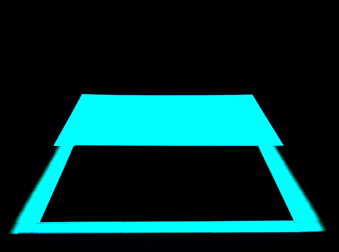Art Interactive begins its third season on a poetic and spiritually resonant tone with its first solo show, Sonalumina-13, a sound installation by Jeff Talman. This site-specific work is a meditative exploration of the space and the elemental properties that are both contained and generated by it.
A minimalist aesthetic pervades this mausoleum-like installation. Three aluminum panels on the floor are raised up by speakers, one panel is mounted on the wall, and one is hanging at an angle from the ceiling. Video projections of cycles of spectral light shifts illuminate the panels. The panels, while not reflective, radiate the light deeply, moving from daylight hues, into dusk, fading to sunset and then a deep underwater green, presenting an astonishing progression of tones. These colors are in fact the spectrum generated by burning aluminum. There is an exquisite symbiosis of sound and light in this installation, and the sound that fills the space seems to record some cosmic germination and movement from particle to planet, presenting us with an elemental deep time. The imperceptible shifts from one color to another create a pulsation that suggest that the space is breathing or that we are witnessing something vast and sacred. The square panels present us with an architectural geometry, and suggest windows into another sphere. Talman effects a perspectival shift; it’s as if we’re looking at an amplification of an invisible phenomenon, Talman has made visible and audible for us something felt, but not seen. The aluminum panels create a macroscopic version of what is already there, throwing these elements of the space into sharp relief. The installation is very much about the space, but it doesn’t hold us there, and we are invited to wander through a larger resonant landscape creating a dialogic movement between intimate and vast space.
Art Interactive’s aluminum floor inspired Talman as an evocative surface with which to engage. In his sound installations, Talman has consistently looked for equivalencies between light and sound, in an effort to bypass the sculptural object. I would argue, that these objects, however, although magnifications of, or metaphors for the floor panels, are compelling in their objecthood and recall the pristine geometry of Judd or LeWitt. The human presence in this installation is available to us in Talman’s process, his scientific and perceptual explorations of the space. He analyzes the room tone, which is essentially the silence of the space. He records radical silence, which is a kind of pure emptiness uninterrupted by traffic and other irrelevant noise. It does contain wind currents and he compares the process to that of blowing into a bottle, except in this case, the bottle is the room. The tone of reverberation, as we know, is dependent on the size and shape of the container that we blow into. In this radical silence, Talman measures the standing waves of the space. From these measurements, he extracts resonance from the room tone. He puts this tone back into the space that created it so that it ‘fits’ perfectly. In order to engage the aluminum directly, Talman took some of the panels out of the floor, and struck them to see what kinds of resonances came directly off the material, and used these in the sound program as well. The twelve speakers under the floor are tuned to the aluminum plates and standing in the right place, one can feel the plates vibrating under ones feet. The sound and vision of the installation is generated by a randomization program consisting of 9 audio programs and 13 video programs.
Talman, a classically trained composer, attributes his initial fascination with resonance as coming out of his experiences of living in a country where he didn’t understand the language, and therefore became very sensitive to sounds. Visiting churches and cathedrals in Prague, Talman became aware of distinctive space tones and set out to use these connections in his work. He became conscious of silence as the kind of ‘negative space’ that both exists around and defines an object. Similarly, ‘negative sound’ exists around us and directs our perception of space. Be prepared to spend some time in this space and it will certainly resonate.
Links:
Art Interactive
"Sonalumina-13" is on view until October 24th at Art Interactive, located at 130 Bishop Allen Dr., Cambridge, MA.
All images are courtesy of the artist and Art Interactive.
Jessica Poser is an artist, educator, and doctoral candidate at Harvard University. Jessica is a new contributor to Big, Red & Shiny.



